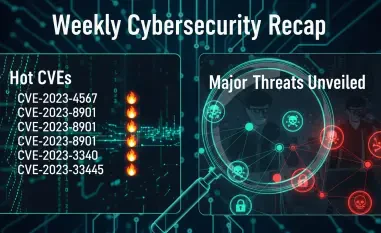A New Frontier in Cybercrime
In a startling development, cybercriminals have harnessed blockchain technology, often celebrated for its security and transparency, to orchestrate sophisticated malware distribution schemes that pose significant threats to digital safety. A notable tactic, dubbed EtherHiding, leverages smart contracts on platforms like BNB Smart Chain to conceal and deliver malicious code, presenting an unprecedented challenge to cybersecurity defenses. This alarming trend underscores a dangerous convergence of cutting-edge technology and cybercrime, where decentralized systems become tools for deception. The significance of this issue lies in its potential to evade traditional detection methods, exploiting the very features that make blockchain appealing. This analysis delves into the mechanisms behind blockchain-based malware distribution, examines real-world cases, incorporates expert insights, explores future implications, and offers key takeaways for navigating this evolving threat landscape.
The Rise of Blockchain as a Malware Distribution Tool
Emergence and Growth of EtherHiding Tactics
Blockchain technology, initially designed for secure and transparent transactions, has been repurposed by threat actors to distribute malware with alarming efficiency. The EtherHiding tactic, first documented by Guardio Labs in late 2023, utilizes smart contracts on networks like BNB Smart Chain to embed and obscure malicious code, blending it with legitimate Web3 activities. This method capitalizes on the immutable and decentralized nature of blockchain, making it difficult for security teams to intervene or remove harmful content once it’s deployed.
Recent data from Google Threat Intelligence Group (GTIG) reveals the scale of this threat, with approximately 14,000 compromised web pages flagged as linked to the threat actor UNC5142 as of mid-2025. These figures highlight the rapid proliferation of such tactics over a short period, showcasing how cybercriminals continuously refine their methods to exploit decentralized systems. The evolution of EtherHiding reflects a calculated shift toward leveraging emerging technology for illicit purposes.
The persistence of this trend over the past year and a half demonstrates its adaptability, with attackers frequently updating their infrastructure to maintain operational effectiveness. Low-cost modifications to smart contracts, often costing between
The persistence of this trend over the past year and a half demonstrates its adaptability, with attackers frequently updating their infrastructure to maintain operational effectiveness. Low-cost modifications to smart contracts, often costing between $0.25 and $1.50 per update, allow for quick adjustments without disrupting the attack chain. This cost-effectiveness, combined with the resilience of blockchain networks, positions EtherHiding as a formidable tool in the cybercrime arsenal.
.25 and .50 per update, allow for quick adjustments without disrupting the attack chain. This cost-effectiveness, combined with the resilience of blockchain networks, positions EtherHiding as a formidable tool in the cybercrime arsenal.Real-World Applications and Case Studies
A prominent example of blockchain malware distribution involves UNC5142, a financially motivated group targeting compromised WordPress sites to spread information-stealing malware such as Atomic, Lumma, and Vidar. These sites serve as initial vectors, where malicious JavaScript is injected into plugin or theme files, exploiting vulnerabilities in outdated or poorly secured content management systems. This approach has proven effective in reaching a broad audience of unsuspecting users across Windows and macOS platforms.
The attack chain often begins with a JavaScript downloader known as CLEARSHORT, which retrieves encrypted payloads from blockchain smart contracts. A notable social engineering tactic, dubbed ClickFix, tricks users into executing harmful commands via the Windows Run dialog or macOS Terminal app, bypassing automated defenses. Campaigns observed between late 2024 and early 2025 illustrate how these multi-stage infections unfold, with payloads executed in memory to avoid detection by traditional antivirus software.
Further sophistication is evident in UNC5142’s use of a three-contract architecture, adopting a Router-Logic-Storage design to enhance flexibility. This setup, rolled out by late 2024, enables rapid updates to critical components like landing page URLs without altering the compromised site’s code. Such tactical advancements, paired with encrypted landing pages on domains like Cloudflare .dev, underscore the group’s ability to adapt and evade mitigation efforts during active campaigns.
Expert Perspectives on Blockchain Malware Challenges
Cybersecurity professionals from Google Threat Intelligence Group and Guardio Labs have expressed significant concern over the challenges posed by blockchain-hosted malware. The decentralized nature of blockchain networks complicates detection and disruption, as malicious content remains accessible on public ledgers, resistant to conventional takedown strategies. This inherent durability forces defenders to rethink approaches traditionally reliant on centralized control points.
Additional analysis from Sekoia, focusing on related frameworks like ClearFake as of early 2025, highlights the reliance on user-dependent attack vectors. These methods exploit human error through social engineering, such as fake browser update prompts, to initiate infections. Experts agree that this trend toward manipulating user behavior represents a critical vulnerability that automated systems struggle to address effectively.
There is a broad consensus on the urgent need for novel security frameworks to counter the misuse of decentralized technologies. The persistent targeting of platforms like WordPress, often due to unpatched plugins or weak configurations, further amplifies the risk. Specialists advocate for enhanced monitoring of blockchain transactions and improved user education to mitigate the impact of these evolving threats on digital ecosystems.
Future Outlook for Blockchain Malware Threats
Looking ahead, the potential for blockchain malware tactics to become even more intricate looms large. Threat actors may develop increasingly complex smart contract architectures, possibly integrating with other emerging technologies like artificial intelligence to automate and personalize attacks. Such advancements could render current defenses obsolete, necessitating a proactive shift in cybersecurity strategies.
Significant challenges persist, including the difficulty of tracing low-cost updates to malicious contracts and the inherent resilience of decentralized networks against coordinated takedowns. The financial accessibility of these updates allows attackers to maintain agility, frequently altering their infrastructure to bypass detection. This adaptability suggests that similar tactics could spread to other threat groups, amplifying the overall risk to web security.
Broader implications point to the urgent need to strengthen content management systems like WordPress against exploitation while developing robust defenses against social engineering and in-memory execution techniques. On a positive note, this threat could spur innovation in security tools tailored for decentralized environments. However, a negative outcome remains possible, with increased adoption of blockchain malware tactics potentially overwhelming unprepared organizations and individuals if countermeasures lag behind.
Final Reflections and Next Steps
Reflecting on past developments, the weaponization of blockchain through tactics like EtherHiding by groups such as UNC5142 marked a pivotal shift in cybercrime. The staggering scale of 14,000 compromised WordPress sites and the intricate attack chains involving CLEARSHORT revealed the depth of this challenge. The sophistication of these methods, observed in campaigns stretching into mid-2025, exposed critical gaps in existing defenses.
Moving forward, organizations and individuals must prioritize fortifying digital infrastructures, particularly by securing widely used platforms and educating users on social engineering risks. Collaborative efforts between cybersecurity firms and blockchain developers could yield innovative tools to monitor and neutralize malicious smart contracts. A proactive stance, embracing adaptive security measures, has become essential to outpace the evolving tactics of cybercriminals in this domain.













